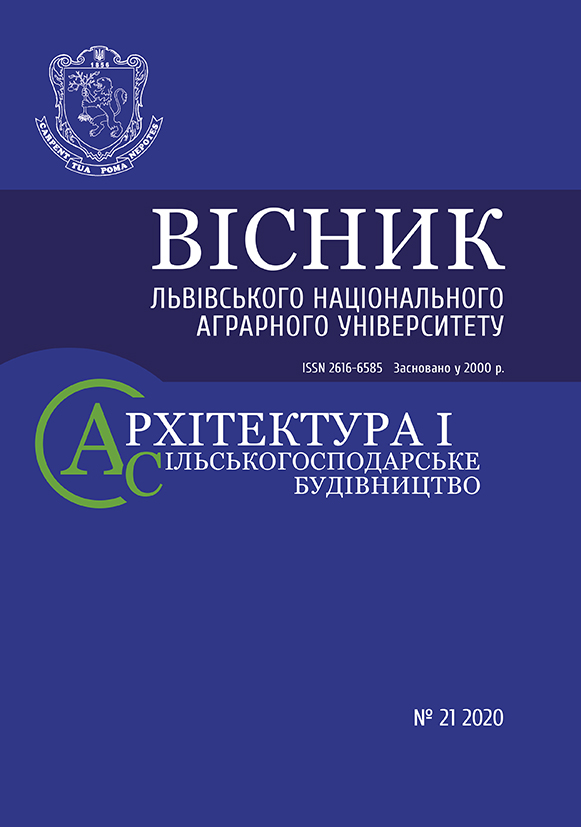Visnyk LNAU: Architecture and Farm Building 2019 №20: 5-8
НEAT LOSS THROUGH THE WALLS OF LOW-RISE RESIDENTIAL BUILDINGS WITH A WOODEN FRAME
Bodnar Yu., PhD
Lviv National Agrarian University
Buchaniec D., Candidate of Engineering Science
University of Economy in Bydgoszcz
https://doi.org/10.31734/architecture2019.20.005
Annotation
The research concerns heat loss through the wall fences of a one-storey residential building with a wooden frame, made of 50 x 150 mm bars. The insulation is done with mineral wool, being 150 mm thick. The carcass is made according to the Canadian technology with the installation of window headers. The work studies the effect of heat transfer of such heat-conducting inclusions on the reduced resistance. The inclusions can be in the form of angles, window slopes, and frame racks. To determine the reduced resistance of heat transfer, the modeling of wall fragments by the finite element method was performed using the Agros2D software. Calculations of the wall fragments supplied temperature fields and heat fluxes. Linear heat transfer coefficients for linear heat-conducting inclusions are calculated According to the normative method, based on computation of two-dimensional temperature fields of wall fragments. The research determines a degree of influence of each heat-conducting inclusion. It is concluded that thermal conductive inclusion, such as frame racks (heat loss accounts for 23.4%) and side slopes of windows (heat loss accounts for 7.7%), have the greatest effect on heat loss in the studied building with a wooden frame. Considering the effect of heat-conducting inclusions, the heat transfer resistance decreased, while the total heat loss increased by 33%. A significant decrease in the reduced heat transfer resistance with consideration of heat-conducting inclusions of the frame, as well as the temperature at heat-conducting inclusions in the window slopes below the dew point, confirm that it is necessary to apply cross-insulation of the wooden frame for the construction in the first temperature zone in Ukraine. The research results will be useful for the design of low-rise wooden-framed houses.Key words
residential building, wooden frame, resistance to heat transfer, linear thermal conductors, flat temperature problem, finite element model, Agros2D software complex
Link
- Protasevich A.M., Krutilin A.B. Reduced heat transfer resistance of modern outdoor enclosure of buildings and structures. Energy efficiency. 2013. № 8. P. 20–25.
- Bodnar Yu. Pyts O. Heat engineering characteristics of external aerated concrete walls of one-storey residential building with consideration of heat conducting inclusions. Materials of the XVIII International Scientific and Practical Forum «Theory and Practice of the Agro-Industrial Complex and Rural Territories Development», 2017. P. 335-338.
- Krivoshein A.D., Fedorov S.V. About computation of the reduced total thermal resistance of walling. Journal of Civil Engineering. 2010. No.8. P. 21–27.
- Murray S. Thermal bridging and whole building energy performance / Morrison Hershfield, Ontario Association of architects. URL:http://www.oaa.on.ca/oaamedia/documents/Thermal%20Bridging%20And%20Whole %20Building%20Energy%20Performance.pdf (accessed: 24.06.2019).
- Semko O.V., Yurin O.I. Effect of mutual location of the outside angle of the building and its window opening on the temperature of the inside angle surface. Poltava National Technical Yurii Kondratiuk University. Academic Journal, Series: Industrial Machine Building, Civil Engineering. 2013. 4(2). P. 182-190.
- DSTU B V.2.6-189: 2013. Methods of choice of the insulation material for buildings insulation. Kyiv, 2014. 51 p.
- DSTU ISO 10211-2: 2005. Heat conducting inclusions of building constructions. Calculation of heat flow and surface temperatures. Part 2: Linear thermal bridges. Kiev, 2008. 12 p.
- Filonenko O.I., Yurin O.I. Energy efficiency of houses: Textbook. Poltava: Astraia, 2018. 484 p.
- DBN B.2.6-31: 2016. Thermal insulation of buildings. Kyiv, 2017. 31 p.



